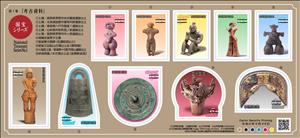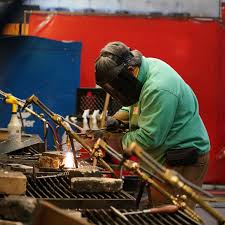Mini Sheet: Treasures from the Yayoi and Kofun Eras (Japan 2020)
Treasures from the Yayoi and Kofun Eras (Japan 2020)
29 May (Japan ) within release 4th National Treasures Series (1st issue) goes into circulation Mini Sheet Treasures from the Yayoi and Kofun Eras face value 10*63 Japanese yen
| Mini Sheet Treasures from the Yayoi and Kofun Eras in catalogues | |
|---|---|
| Yvert et Tellier: | Yt: JP 9903-9912 |
Mini Sheet is horizontal format.
Also in the issue 4th National Treasures Series (1st issue):
- Stamp - Jōmon Venus face value 63;
- Mini Sheet - Treasures from the Yayoi and Kofun Eras face value 10*63;
- Stamp - Hollow Dogū face value 63;
- Stamp - Gasshō Dogū face value 63;
- Stamp - Jōmon Goddess face value 63;
- Stamp - Masked Goddess face value 63;
- Stamp - Haniwa Armored Male Statue face value 63;
- Stamp - Bronze Ritual Bell face value 63;
- Stamp - Bronze Mirror face value 63;
- Stamp - Flame-style Pottery face value 63;
- Stamp - Gilt-Bronze Saddle Fitting face value 63;
- Stamp - Engaku-ji Reliquary Hall face value 84;
- Mini Sheet - Buildings from the Nara and Muromachi Eras face value 10*84;
- Stamp - Tōdai-ji Belfry face value 84;
- Stamp - Daigo-ji Five-Story Pagoda face value 84;
- Stamp - Chūson-ji Golden Hall face value 84;
- Stamp - Ishiyamadera Tahōtō face value 84;
- Stamp - Kōfuku-ji North Octagonal Hall face value 84;
- Stamp - Mt. Mitoku Sanbutsu-ji Nageiredō face value 84;
- Stamp - Jōdo-ji Treasure Tahōtō face value 84;
- Stamp - Shōsōin Repository face value 84;
- Stamp - Mt. Haguro Five-Story Pagoda face value 84;
Mini Sheet Treasures from the Yayoi and Kofun Eras it reflects the thematic directions:
Archaeology or archeology[a] is the study of human activity through the recovery and analysis of material culture. The archaeological record consists of artifacts, architecture, biofacts or ecofacts, sites, and cultural landscapes. Archaeology can be considered both a social science and a branch of the humanities. It is usually considered an independent academic discipline, but may also be classified as part of anthropology (in North America – the four-field approach), history or geography
Metalworking is the process of shaping and reshaping metals in order to create useful objects, parts, assemblies, and large scale structures. As a term, it covers a wide and diverse range of processes, skills, and tools for producing objects on every scale: from huge ships, buildings, and bridges, down to precise engine parts and delicate jewelry.
A statue is a free-standing sculpture in which the realistic, full-length figures of persons or animals are carved or cast in a durable material such as wood, metal or stone. Typical statues are life-sized or close to life-size. A sculpture that represents persons or animals in full figure, but that is small enough to lift and carry is a statuette or figurine, whilst those that are more than twice life-size are regarded as colossal statues.



